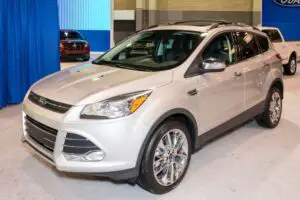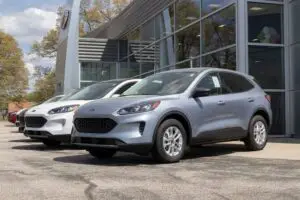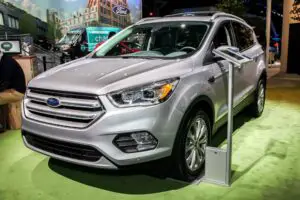Since there can be numerous reasons why your Ford Escape is not starting, it can be frustrating to try and pinpoint the exact one causing the problem when yours doesn’t start.
In addition, the vehicle not starting means paying expensive repair bills. Here I have tried to ease your problem by compiling the most likely reasons the Ford Escape isn’t starting.
If you’re looking for the answer to “Why won’t my Ford Escape Start?” continue reading the following article.
When looking for the issue, eliminate the most likely possibilities and move on to the less likely ones.
Some likely reasons the car won’t start are:
- A Bad Or A Dead Battery
- Fault With The Alternator
- Faulty Starter
- Bad Fuel Pump
- A Clogged Fuel Filter
- Fault In The Spark Plug
Here I will discuss these common causes, how you can indicate them, and what you should do to fix them.
There is also a list of the most frequently asked questions about the Ford Escape not starting by the end of the article.
Therefore be sure to check them out as well, as they might address your possible issue.
Table of Contents
- 1 What Would Cause A Ford Escape To Not Start?
- 2 Frequently Asked Questions
- 2.1 Q1. Why Won’t My Ford Escape Start With New Battery?
- 2.2 Q2. Why Won’t My Ford Escape Start Even With A Jump?
- 2.3 Q3. Why Won’t My Ford Escape Start But Lights Work?
- 2.4 Q4. Why Won’t My Ford Escape Start But Cranks?
- 2.5 Q5. Why Won’t My Ford Escape Start Just Clicks?
- 2.6 Q6. Why Won’t My Ford Escape Start In The Cold Weather?
- 2.7 Q7. Why Won’t My Ford Escape Start After I Get Gas?
- 2.8 Q8. Why Won’t My Ford Escape Start But Radio Works?
- 3 Conclusion
What Would Cause A Ford Escape To Not Start?

Here are the most common reasons your Ford Escape might not start and how to fix these issues when they occur.
Read everything carefully to fix the problem. Getting the right diagnosis is extremely important.
1: A Bad Or A Dead Battery
Some of the most common reasons your battery has gone bad might be corrupted or loose battery connections, issues with charging the battery, persistent electrical drains, harsh weather, or demanding more power than it is possible for the alternator to provide constantly.
Charging issues might include fast or overcharge, whereas vibrations might cause the problem.
Around fifty percent of battery failures are due to water loss for normal recharging because of bad maintenance or evaporation from the heat that underhood produce.
The battery charges itself when the Ford Escape is driving.
For this reason, if the vehicle is not driven for long periods or only driven for very short periods, this might cause the battery to die down.
If this is the issue, you first have to indicate if the reason your engine isn’t starting is a dead or bad battery.
What Should You Do About It?
- Always keep jumper cables inside your vehicle wherever you go, as there might be a possibility that the battery dies down unexpectedly and you need them.
- To restart the vehicle, connect the jumper cables to the engine and see if your Ford Escape starts.
- If the Ford Escape doesn’t start, you need a new battery, or the issue lies elsewhere. Remember to never jump-start the vehicle if the car is cracked or leaking visible acid.
- Another reason the battery might be dead could be due to low electrolyte levels in the engine.
- In this case, adding distilled water will solve the problem by submerging the plates and enabling a more reaction area.
2: Fault With The Alternator
Another reason the engine might not start is a bad alternator.
If the battery cannot produce enough power output, it might strain the engine if it tries to start up and then run, which might cause the engine to stall out.
If, for example, you have a good battery, the faulty alternator might be the problem.
Signs that your Ford Escape has a bad alternator are when the vehicle does not start, has trouble starting, the lights are dimming, or there are issues with the stereo system output.
If your car is starting but stalling when underway, the faulty alternator prevents your battery from getting charged.
Therefore, if you hear a squealing sound from the engine and it gets louder when the sound system or heater is on, this could be the alternator bearings.
Also, if you turn the AM radio to a low number without music, try revving your engine, and hear a whine, or if the sound is going fuzzy when hitting the gas, this could be the failing alternator.
If the alternator is bad, it can damage the battery; however, if the battery has gone bad, this will not affect the alternator.
What Should You Do About It?
- If the car isn’t starting due to a faulty alternator, try to jumpstart it by finding someone with a good battery.
- You have to ensure that the other person’s battery is fully charged.
- Before you start the jumpstart, let the other car’s engine run for about three to four minutes.
- You should have the jumper cables connected beforehand, and your Ford Escape should be turned off.
- Remember to have all the car’s accessories, e.g., the heater, air conditioner, phone charger, and radio, turned off. This will help you conserve all the battery power you can get.
- If the Ford Escape does start after the jumpstart, then quickly drive it to the mechanic.
- You might not have more than five minutes, so a towing truck will be needed if the mechanic is far away. Also, driving slowly will help increase efficiency when doing so.
3: Faulty Starter
The starter is supposed to start your engine up; if this is damaged, then starting the Ford Escape will not be possible.
In this case, it will turn over; however, it sounds like it is trying to start without doing so.
If a click noise is made when starting the car, then this can indicate that the problem lies in the faulty starter.
The starter is a small motor that the battery powers. It sits between the starter motor and the battery and transmits power between them.
If the engine isn’t starting and the dashboard lights up without any powering up, the problem might be with the starter.
Another indicator of a bad starter is when the engine does not crank. There is smoke from your car or if the oil has soaked up the starter.
Common reasons for a bad starter include battery corrosion, loose wiring connected to the starter, the connections at the starter being dirty or corroded, oil leaks, the starter including any worn out or damaged parts, or a bad fuse or relay.
What Should You Do About It?
- Try tapping the starter lightly with a hard object a few times, but remember not to pound it. This might help power it back up because this might tap the electrical components back into contact.
- However, this will only fix the problem temporarily; therefore, remember to visit a mechanic as soon as possible.
- Remember to rule out other possible causes first, but if the issue lies with a bad starter, then it is time to get it replaced by visiting the nearest mechanic shop.
4: Bad Fuel Pump
It is also possible that the Ford Escape is not starting because of a bad fuel pump.
If it is faulty or isn’t working, it will be unable to produce the pressure needed to push the gas throughout the entire system, which is needed to run the Ford Escape.
This issue might occur if, for example, you have filled the tank with the gas of low quality.
Because low-quality gas has dirt and debris inside of it, this might clog up your fuel filter and damage and stop the fuel pump from properly working.
Also, fuel pump failures might occur due to electrical faults or wear from old age.
These failures usually occur without any warnings, and because fuel pumps usually go faulty easily, they are one of the most replaced fuel system components.
What Should You Do About It?
- If this is the problem, you should check the connections and ensure they are secure.
- You also have to confirm that there is no dirt or debris in the fuel pump or the tubing, which might clog things up.
- The simplest way to solve the problem of the faulty fuel pump is to get a replacement, and car parts commonly replace fuel pumps.
- It is recommended not to try it out and instead take your Ford Escape to a mechanic to get this done.
- This is because modern fuel pumps aren’t the same way they used to be.
5: A Clogged Fuel Filter
If the filter fuel is dirty and has metallic fragments clogged up inside, this will narrow down the space for the gas to go through, which will be prevented from passing through.
If the clogging is severe, no gas will pass through, and the engine might stall or not start. The metallic fragments which clog up filter fuels come in many different forms of ferrous metals.
These can come from many different sources. However, mostly, these are picked up by the fuel stored in the fuel tanks that might be going through deterioration.
You can indicate this problem if the Ford Escape has rough idling, poor fuel mileage, or the check engine light comes on.
If the light is on, it is time for you to visit a mechanic shop. If you hear loud noises from the fuel pump or a fuel system component failure, this also indicates a clogged fuel filter.
What Should You Do About It?
- If the clogging is not that much grimy, you can clean it yourself and reuse the same fuel filter.
- Before cleaning, relieve the fuel system’s pressure and make sure the battery is disconnected.
- Then remove the filter from the fuel lines and spray using a solvent cleaner. Then let it dry for at least an hour before reinstalling it. Then reconnect the battery and try running the engine.
- If the fuel filter issue is severe, however, you must go to a mechanic shop to replace it.
6: Fault In The Spark Plug
Spark plugs start the spark needed to start the engine and run smoothly.
If the spark plugs have become old and worn out or are damaged, they will not be able to produce the spark needed to start the engine.
Bad spark plugs can be caused by dirty air filters, driving too much at very low speeds, if the air-fuel mixture is too rich, if the fuel injectors are dirty or if the Ford Escape has been idling for too long.
You can indicate bad spark plugs if the engine idles, the car does not accelerate, the engine is too loud, the engine misfires, the Ford Escape gets poor fuel economy, or the check engine light is on.
The engine not starting is itself an indicator. Idling sounds are the best indicator for faulty spark plugs.
These are any rattling, knocking, or pinging sounds or vibrations. Gas mileage and acceleration will reduce as well.
What Should You Do About It?
- Firstly, it is very important to refrain from keeping the same faulty spark plugs as other more serious and costlier issues to resolve might occur from doing so.
- Take your vehicle to a mechanic to fix the spark plugs as soon as possible.
- As the Ford Escape might not be starting, you might need to tow it to a repair shop to do so.
Frequently Asked Questions
Q1. Why Won’t My Ford Escape Start With New Battery?

Sometimes, even replacing the engine with a new battery or getting a newer one will not solve any issues, and the Ford Escape might not start.
This may be due to corroded battery cables. If the corrosion is severe, this will prevent making a good connection.
Therefore the electrical power will reduce and sometimes cause the Ford Escape to not start.
Q2. Why Won’t My Ford Escape Start Even With A Jump?
There are two reasons why your vehicle might not start after a jump.
The first is the possibility of the jumper cables not being good enough, for example, not thick enough to be carrying enough current.
However, the Ford Escape not starting after a jump might indicate that the issue lies with the starter, the alternator, or another electrical system component.
Q3. Why Won’t My Ford Escape Start But Lights Work?
If the Ford Escape headlights are turning on, but the vehicle isn’t cranking, then the issue might lie in the starter or the ignition. This means that the battery is charged, however.
If the issue lies in the starter or the ignition, then you can use a charged battery to jump the starter engine.
Other possibilities of causes are the battery, the battery cable, the starter fuel pump, or the ignition switch.
Q4. Why Won’t My Ford Escape Start But Cranks?
When your Ford Escape is cranking but not starting, it most probably means that the engine is having problems in producing a spark, creating compression, or getting fuel.
The most common reasons are ignition issues, for example, with the ignition coil, or issues with the fuel system, like a clogged fuel filter for example.
Q5. Why Won’t My Ford Escape Start Just Clicks?
If the Ford Escape is not starting and only clicking, then this might indicate a battery or an alternator problem.
Either the battery is dead, or the alternator, which is supposed to charge the battery, isn’t working properly.
If the clicking is happening due to electrical reasons, this indicates that the starter is out of juice to stay powered.
Q6. Why Won’t My Ford Escape Start In The Cold Weather?
The cold weather can put a lot of strain on your Ford Escape’s battery, which increases with the intensity of the cold. This might cause it not to be able to start up.
The reason for the strain is the increase in electrical resistance put on the engine. Therefore it is harder for the battery and spark plugs to carry out their job.
Q7. Why Won’t My Ford Escape Start After I Get Gas?
If the EVAP purge control valve is stuck open, this is the most likely reason for the Ford Escape not starting. This will cause fuel vapor to be pushed into your engine’s intake manifold.
However, other reasons include clogging in the filter fuel, a bad fuel pump, or a bad battery.
In addition, the catalytic convertors could be faulty, the O2 sensor might have gone bad, or the MAF sensor might be dirty.
Q8. Why Won’t My Ford Escape Start But Radio Works?
It might be possible that the Ford Escape’s radio is working; however, the vehicle isn’t starting, and you also cannot hear anything when you try to start it.
This is when the starter motor is not receiving power which indicates a problem in the ignition system.
This problem could lie in the starter solenoid, the battery, or the ignition switch.
Related: The 11 Most Common Ford Escape Transmission Problems
Conclusion
In addition to these, if you are wondering “Why won’t my Ford Escape start?” then there are many other reasons which might be preventing your Ford Escape from starting.
For example, corroded battery cables, fuel line leaks, or a dead key fob for newer models. The most common ones have been listed above.
Even though the Ford Escape is less likely to have issues that need to be repaired, I hope you have found a possible solution if your Ford Escape is not starting.
Also, make sure to eliminate every possible cause before you find the problem, and going to a licensed mechanic might be the best option in severe cases.

I am Tahir Azam, and I have been writing amazing articles for TaxiHack for as long as I can remember. I know everything that is to know when it comes to automobiles and is always on top of industry news and developments. While I am not an expert by any means, I pride myself on knowing the ins and outs of many different problems and, of course, their solutions. The articles on our website are some of the best and well-researched content that you will find, and I spend countless hours making sure this remains to be true. This is why I ask you to take your time out and read some of my articles, especially if you find a topic that resonates with you or is something you are looking into. This way, you will find the perfect mix of information and tips on your desired topic. Learn more about Tahir.


